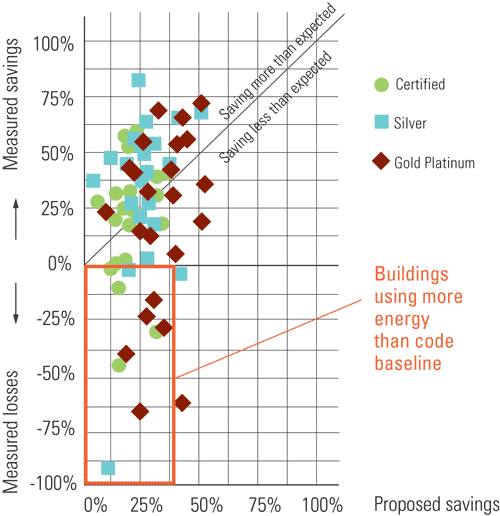LEED Looks Ahead With an Ambitious Overhaul
One aspect of LEED 2009 should help the USGBC with a long-term goal of better understanding the relationship between credits and building performance. As part of project registration, teams will need to agree to report postoccupancy energy and water use. There will be a number of ways to fulfill this provision, including participation in the existing buildings program, which has a performance measurement requirement, or signing a waiver that would allow the USGBC to obtain the information directly from the utility company. The council hopes to use the data to perform studies like the somewhat controversial one it commissioned from the New Buildings Institute (NBI). Completed in March 2008, the NBI analysis determined that energy use in LEED buildings is 25 to 30 percent better than the national average. However, it also showed large variations among individual buildings. According to one of the study's analyses, 25 percent of the participating projects had better than expected performance, while 21 percent showed performance that was below the code baseline.

LEED 2009 for New Construction introduces a requirement that project teams report postoccupancy
energy- and wateruse data. The USGBC hopes that the provision will help it better understand
the relationship between LEED and building performance, and will facilitate studies like the one
it commissioned from the New Buildings Institute. Although the study found that LEED buildings
perform 25 to 30 percent better than average, the analysis also showed large variations among individual
buildings. A comparison of measured versus proposed savings (above) showed that some projects
used more energy than allowed by the code.
Data: NBI

The study also highlights a problem that is just as important as its findings: the difficulty of collecting performance data. NBI's examination is based on 22 percent of the 552 buildings that had been certified under LEED for New Construction Version 2, through December 2006. Only these 121 projects were able to supply the full-year of postoccupancy energy numbers required for participation in the study. Collecting the data for even this small pool of projects required "an extraordinary level of effort," according to Owens. The hope for the new reporting requirement is that it will "automate the collection of data to inform the future development of the rating system," he says.
The LEED v3 launch also includes an improved tool for managing the project registration and certification process electronically. The council, in collaboration with software companies Adobe and SAP, developed the application in response to complaints that the system's predecessor is slow, buggy, and prone to frequent crashes. "The
USGBC staff uses it on a daily basis, so we are aware of its shortcomings," says Mike Opitz, USGBC vice president of LEED development. System designers also sought input from other frequent users, such as project administrators and reviewers, he says.
The new LEED Online, which will be available for use only in conjunction with LEED 2009 projects (those registered under previous versions of LEED will be required to continue to use the older online system), represents an investment of "several million dollars," says Opitz. In addition to providing improved speed and reliability, the application is designed to facilitate communication between the reviewer and the project team, according to the council.Â
Along with the revamp of the rating system and the online application, LEED v3 includes an overhaul of the project certification process and the program for qualifying LEED Accredited Professionals (AP). In conjunction with the v3 launch, the USGBC officially moves administration of the certification and AP programs to the Green Building Certification Institute (GBCI), a nonprofit organization spun off from the USGBC in late 2007. The council will continue to manage the development of the rating system, the online tool, and related resources such as educational offerings.









